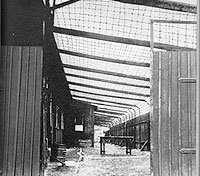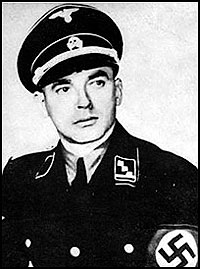|
|
 |
 |
|
FEATURESThe Improbable Tale of Krueger’s MenCould the Nazis destabilize the British economy with counterfeit pounds produced by concentration camp prisoners? 
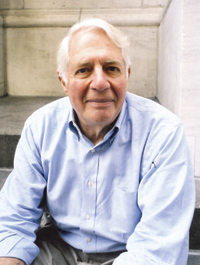
Lawrence Malkin ’51 first heard of the forging scheme in the 1960s, but did not begin researching Krueger’s Men until 2002. Photo: Abigail Heyman  On September 18, 1939, two weeks after World War II started, a secret Nazi operation was approved at the Finanzministerium in Berlin. The plan was to counterfeit massive quantities of British pounds, air-lift and drop them over Britain and start a mass panic that would destabilize the enemy’s currency. Then the Nazis could sit back and watch as the British economy, like the bombed-out buildings of London, collapsed into rubble. Lawrence Malkin ’51, in Krueger’s Men: The Secret Nazi Counterfeit Plot and the Prisoners of Block 19, tells the improbable story of the Nazis’ counterfeiting operations. Their first attempt, Operation Andreas, failed because of SS political meddling. Then Lt. Bernhard Krueger, chief forger for SS foreign espionage, was ordered to try again using Jewish prisoners plucked from the concentration camps. Between 1942 and 1944, Krueger recruited about 145 men — printers, accountants and even a well-known fashion photographer. The men were housed in Block 19, a barracks enmeshed in barbed-wire inside the Sachsenhausen concentration camp north of Berlin. All of Krueger’s men were aware that their lives depended on their ability to duplicate Britain’s distinctive £5 note. 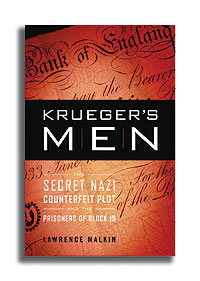 As Malkin notes, “The prisoners worked with the knowledge that they were marked for death when they had finished their jobs. From the start, they wondered whether they should stretch out their work and risk execution for sabotage, or perform efficiently and thus hasten their own deaths.” Between 1942 and 1945, Operation Bernhard produced counterfeits with a face value of £132 million, more than $6 billion in today’s money. Perhaps 10 or 15 percent of the top quality notes made it into circulation. They were used to buy raw materials from unsuspecting neutrals and weapons from defecting partisans, and to pay spies whose intelligence was largely ignored by the high command. Millions also were pocketed by SS money launderers. None of the false currency was ever was flown into Britain. Obsessed by secrecy and bureaucratic turf warfare, Nazi spymasters neglected to acknowledge the fact that the overstretched Luftwaffe had too few planes. In contrast to Germany’s totalitarian regime, when Churchill and Roosevelt considered dropping fake reichsmarks on Germany, Allied specialists subjected it to careful examination and realized the idea might backfire. A German found with the foreign-made counterfeits would probably be shot, and even if any of the fakes were slipped into German bank accounts, they would only provide more money for forced loans to finance Hitler’s war machine. As the Allies closed in on Berlin, Block 19 was dismantled early in 1945 and the prisoners and their equipment were shipped to underground caves in the Austrian Alps. But it was too late to start up again. Sealed containers holding tens of millions of counterfeit pounds were dumped into the Toplitzsee, a deep lake surrounded by the Totes Gebirge (Death Mountains). Krueger sped away in a staff car, leaving SS sergeants with orders to spare none of the prisoners. But while they were being assembled for mass execution, SS guards fled before Patton’s armored columns, and the forgers escaped. After the war, the British began to weave metal threads into the paper of all their notes. As the Bank of England was forced to admit in a 1945 announcement, the additional security measure was due to the “forgery of high sum Bank of England notes in Germany during the war.” During the war, the British had protected themselves by the unusual step of banning the import of pounds, so the continent was flooded with fakes, and they continued to surface in unexpected places. In the story’s crowning irony, thousands of Operation Bernhard pounds fell into the hands of Jewish underground agents smuggling refugees from devastated Europe to Palestine. They used the counterfeit Nazi pounds to charter ships and buy weapons and trucks for the nascent Jewish army. For decades after the war, treasure hunters, using fishing rods and even submarines, continued to try their luck in the Toplitzsee, where much of the false currency was drowned. The washbasins and toilets in the center of Block 19 conveniently separated the workshop from the sleeping quarters, each section about a hundred feet long. The prisoners slept on individual cots, not on standard wooden concentration camp tiers with three or four inmates to a shelf and each man’s feet in another man’s face. They also were assigned personal lockers and exchanged their striped uniforms for used civilian clothing painted with a broad red stripe on the trouser legs and a red cross on the jacket. In many cases the clothes had been worn shiny, but they were warmer and more comfortable than prison rags. The prisoners were also allowed to grow their hair and thus retain some of their individuality. New arrivals were issued a towel and soap, a food dish, and a knife, fork and spoon. They ate at wooden tables, and their rations were black bread and soup that, like all food in Germany, deteriorated throughout the war into a foul brew of grass, tomato leaves and potatoes. It was called spinach soup, although the closest thing to spinach was the sand that got in their teeth. But they also received a small cigarette ration of Zora 10-packs made of yellow tobacco from Yugoslavia, and sometimes they were served jam and even margarine. A majority of the German and Czech prisoners were only part-Jewish and had non-Jewish wives or relatives who were allowed to send them food parcels supplementing their diet. [Avraham] Krakowski recalled arriving early in 1944 to “a bowl of the most delicious hot oatmeal, cooked in milk and sugar, and afterwards, hot coffee with cream and sugar, as much as we wanted” — although it proved too much for this emaciated prisoner from Auschwitz. But they were fed potato-and-sauerkraut soup on Sundays, which were, wonder of wonders, rest days to play chess, cards, Ping-Pong and listen to the state-run radio, from which they could obliquely plot the course of the war. Every week they were led out to the showers, where sadistic guards switched the water from scalding hot to freezing cold without warning. But the men in Block 19 were kept in a semblance of health. So this would be neither a work camp nor a death camp, but halfway between: a death camp with a difference. Like all Jews under Nazi dominion, death was to be their eventual fate, only for them it would be more certain or less, depending on unpredictable events. This is not as unusual as it sounds. Virtually every survivor tells a story in which utter chance plays the determining role.* Once the machinery arrived from Delbrückstrasse and was installed on December 2, 1942, the gates of Block 19 slammed shut. It became a world unto itself, with its own doctor, a Pole named Boris Rojzen; a barber; repairmen; and its own diesel-powered generator to keep the presses rolling in an emergency. One new group was greeted by the chief printer, Arthur Levin from Berlin: “Friends, from here there is no exit. Only an accident can deliver us from this life, and we have to trust in this accident.” When a fire broke out on the barrack’s roof, Krueger’s prisoners had to save their own lives by forming a bucket brigade; machine gunners outside the wire mesh prevented anyone from fleeing with the secrets of Operation Bernhard or firemen from entering to discover them. The prisoners had been warned repeatedly that death was the penalty for disclosing anything about Operation Bernhard. When the stereotyper Moritz Nachtstern was taken to a physician, he was asked what they did in Block 19. With an armed guard at his elbow, the prisoner replied, “Shovel sand.” 
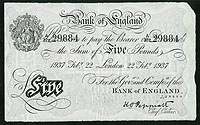 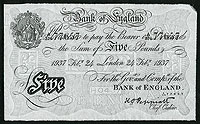
Experts would be hard-pressed to distinguish a high-quality Operation Bernhard forgery (bottom) from the real thing. In this counterfeit, the watermark is slightly misplaced, which is barely visible through the watermark line emerging at the center of the capital N. Photos: Courtesy Colin Narbeth & Son, London  Gradually the workshop expanded into a factory occupying Blocks 18 and 19, which were knitted together by a new barbed-wire mesh of double thickness. One prisoner likened it to being inside a mousetrap. The buildings were separated by a narrow strip for exercise and recreation with four Ping-Pong tables. Inside were the most modern printing machines, a book bindery, a photo laboratory, an engraving workshop and a countinghouse. In addition to the counterfeit pounds, the prisoners forged passports and identification documents. Visas, date markings and rubber stamps were available from an inventory of 68,000 representing government bureaus, banks and other institutions in scores of countries, all stolen or copied from original documents. Trial and error played a part in Krueger’s method. A spot of water dropped unintentionally on a test bill led to the solution of one problem, a drop of household cleanser another. Nor was Krueger above seeking help from the prisoners themselves. Artur Springer, a 55-year-old Czech businessman, had been nursed back to health in a prison hospital to join the vanguard, an extraordinary effort to save any prisoner, especially a Jew. It soon became obvious why: upon arrival, Springer had remarked to his fellow-prisoners that he knew “a little bit about paper.” Shortly after his recovery, Krueger appeared in the barracks, welcomed “Herr Springer” with great courtesy, and allowed the newcomer to precede him through the door of the sleeping quarters to tour the printing plant. During its manufacture at the Hahnemühle factory, the paper for the counterfeit bills had to be watermarked with wavy lines, the batch code of each issue, and the denomination spelled out as 5, 10 and so on. The principles of watermarking are simple: As pulp emerges from the vat, it is almost 99 percent water, which is pressed out by successive rollers or screens, one of which squeezes out slightly less water in an embedded pattern that can be seen when the sheet is held up to the light. Since the watermark is a security feature, it has to be impressed with tolerances to the millimeter and coordinated just as closely with the images printed on the bill. “It took unending patience to discover how the watermark effect was created, its intaglio impress, and its striking dark and light transparencies,” Krueger wrote. Given such demanding specifications, paper production could be erratic. In the early days, there were sometimes no deliveries for several weeks; the prisoners would begin to think that Operation Bernhard had been suspended and they were done for. “It was a nerve-wracking period,” Nachtstern recalled. “Had they discontinued the plant, the road to the crematorium wouldn’t have been long for us.” The Story Behind Krueger’s MenLawrence Malkin ’51 doesn’t remember the exact moment when he first heard about Block 19. During the 1960s, when he worked in the London bureau of the Associated Press as a financial correspondent, stories about the Nazi venture were “in the air,” he says. While Malkin knew it was “a great yarn,” he was engrossed in his AP work at the time and didn’t pursue the tale further. “The light didn’t go on for me,” he says . Many years later, fragments of the story resurfaced in Malkin’s life, like flotsam drifting up from a buried wreck. In the meantime, he had become a Time correspondent, then U.S. correspondent for the International Herald Tribune. He had ghost-written books for Paul Volcker, Anatoly Dobrynin and other notables. Sometime in 2000 or 2001, he was approached by an agent who claimed to have material about the Block 19 episode. This time, Malkin was interested, and he set off on the story’s trail. It can sometimes seem, to a Columbian, as if all roads lead back to the College. One of the first people Malkin spoke to was Murray Teigh Bloom ’37. Bloom, who had written about Lt. Krueger (the leader of Block 19) for Harper’s and The American Weekly, was the first American writer to investigate the story in depth. Bloom, then in his mid-80s, still had transcripts from his conversations with Krueger, from which he allowed Malkin to quote. By now, too, long-secret files at the U.S. and British National Archives and the Bank of England had been declassified, and Malkin was able to reshape and revise Bloom’s original thesis. Framing new information was something Malkin knew how to do, at least partly thanks to his education at Columbia. Malkin calls his Core training “ideal preparation for a journalist.” He has spent his working life being “parachuted into strange situations,” as he puts it. “I’ve covered two wars. I’ve covered finance, theater, arts, a plane crash … any conceivable story.” The Core, he believes, was the best possible training for a job “which regularly throws up disparate material and random impressions in unfamiliar circumstances:” material that needs to be sorted, organized and framed. One of the things in life he’s proudest of is the Phi Beta Kappa key he earned on Morningside Heights. Krueger’s Men took Malkin about three years to complete. Published by Little, Brown at the end of 2006, it’s been a featured alternate of the Book-of-the-Month Club and the History Book Club, and the story of Block 19 was featured on The Wall Street Journal’s front page. Not content to sit back on his laurels, Malkin is at work on his next book, a Wall Street thriller co-authored with Susan Traill. As he writes in one of his essays, “Money talks, and it has always told me good stories.” Rose Kernochan ’82 Barnard The delays arose because Krueger kept trying to achieve a total match but never quite succeeded, and he knew it. He later wrote: “It was never possible to eliminate entirely the difference between the soft-blue fluorescence of the British and the bluish-gray of the B[ernhard]-notes under the quartz lamp. But given the deceptively close visual identity, the odds were against anyone resorting to a quartz lamp … From a psychological view, it was unthinkable to wage war against the English pound with a quartz lamp. Chemical additives did not eliminate the fluorescent discrepancy but markedly weakened it.” Setting aside the problem of paper, an old-fashioned five- pound note appears deceptively easy to counterfeit. Apart from the engraved lines of the Britannia vignette, the bill seems merely to spell out the Bank’s classic promise to pay the bearer a specific sum, with the promise and date arrayed in elegant calligraphy, all guaranteed by the bold signature of the Bank’s chief cashier. The bills had no crosshatched or geometric patterns, known as a guilloche, which are difficult to duplicate and so complex that they now are engraved by computer. There was, however, a code or “cypher” of a few numbers and letters identifying each batch. 
“Your assignment is nothing more and nothing less than the manufacture of enemy bank notes.”  Right into the war, the Bank of England had maintained a complex, cross-referenced process of authentication for each bill it issued. It was the job of the technicians at the Note Issue Office to number, disburse and keep track of all pound notes. The senior officials as well as the technicians at the Bank believed their system to be virtually inscrutable. All notes of five pounds or more were given a place and date — for example: London, August 8, 1938 — and no more than 100,000 bills were printed with that date, often less. Each batch was assigned an alphanumeric code that appeared in small letters — say, B258— its cypher. And each bill had its own serial number indicating its sequence within that batch. There were enough alphanumeric batch numbers to last 40 years, at which point the cycle would start again. But there was no risk of duplication because by then the Office of Chief Cashier, whose bold signature was printed on each bill, would certainly be occupied by someone else. The functionaries of the Note Issue Office believed this would trip up counterfeiters, but with typical British insularity, they overlooked one thing: the pound sterling, as the Germans well knew, was an international currency. Forgers abroad simply had to duplicate a bill that was easy to fake, and then copy the batch and serial numbers straight from a real one. As long as the counterfeit bill did not actually reach Threadneedle Street for inspection (and foreign banks only cabled the dates, numbers, and letters for verification), counterfeits could be blithely passed from hand to hand. Producing a duplicate on a plain press seemed simple to any printing specialist, and matching up the identifying codes only slightly more complex. The least trouble was presented by the ink used by the Bank of England. It was known as Frankfort black because its pigment was made from the charcoal of German grapevines boiled in linseed oil. Schmidt Brothers of Berlin produced it, and Krueger improved it to imitate ink’s normal spread into banknote paper over the years. Since the black-and-white notes first made their appearance in the 1830s, the Bank had erected its own secret hurdles against counterfeiting. During the Weimar Republic, the Reichsbank recognized this and asked for samples, which were supplied with great reluctance by London and heavily stamped SPECIMEN. It was only after many different pound notes from the Germans’ regular stock were enlarged and projected onto screens in Friedenthal and Sachsenhausen that sharp-eyed engravers in both places, working on different bills in tandem and literally comparing notes, realized how many security marks had been deliberately designed to pose inconspicuously as minor printing flaws. Before the war, most freelance counterfeiting gangs ignored these marks at their peril, underwriting the Bank’s smug certainty that its specialists would quickly recognize any fakes and confiscate them. Over the years, the Bank’s engravers had carved as many as 150 different security marks, varying them as they changed plates for new issues after press runs of 100,000. The Britannia medallion itself always had three secret marks: a group of five dots on the back of her right hand, a shading line down the length of her spear that stopped slightly short of the base of its handle, and a hairline break across the shading lines in the upper-right section of foliage surrounding the figure. On some issues, the shield was irregularly curved and the sea variously shaded. The prisoners came to call the engraving “Bloody Britannia” and missed some of these details, but not many, as they learned to become master counterfeiters, spotting and duplicating the purposely malformed text letters, the tiny nicks in the large letters of the elaborately carved blocks that denoted the value of each bill in words rather than numbers, and the almost invisible dots they called “fly-specks.” They soon learned to look for a tiny, off-center dot just above the i in the signature of chief cashier Peppiatt. Furthermore, one p in his name had a little swallowtail; if the plate had been too heavily inked, it would blur or blot out. One morning in 1943, Krueger arrived with proof of their success. He pulled a sterling note out of his pocket and smiled as he waved it in the air. “Look at this, gentlemen. This note has been circulating in English banks and accepted as genuine. Congratulations on excellent work. I’m proud of you, gentlemen. Now we can really go to town. We are going to expand the plant.” As a reward, he ordered loudspeakers to pipe in German radio, but their spirits were already high with the news that the operation was succeeding and growing larger. They had won a further reprieve from the gas chamber, and a jubilant Krueger had won their grudging respect. “One would think he had already been appointed Governor of the Bank of England,” said Max Bober, a Berlin printer and barracks wit. As new recruits arrived, most of the men went on 12-hour shifts starting at 6 a.m. and 6 p.m. so production could continue around the clock. It reached its peak in midsummer 1943, when more than 100 workers produced an average of about 650,000 notes a month, until about mid-1944. Six flatbed presses, including four of the latest Monopol Type 4 models with special registering apparatus and manufactured under special wartime priority, spewed out 5-, 10-, 20- and 50-pound notes. (Krueger stopped there because he knew that hundred-pound notes would always be examined closely, probably too closely.) Each press had two pressmen. The walls of the room were lined with wooden crates full of blank paper awaiting watermark inspection, and the tables were piled high with half-finished notes whose massive presence some prisoners found overwhelming. The room was sectioned into areas for cutting, aging and sorting — Reisserei, Altmacherei and Sortirei. The printed sheets were laid on a drying rack, then torn into four individual bills with a steel ruler and stacked in bundles of one thousand. Then the sides were roughed up with metal rasps to imitate the deckle edge. A double line of prisoners with intentionally dirty hands aged the bills artificially by rubbing, folding and puncturing them, writing English words on them with English ink, and stamping the names of English banks on the reverse side to manufacture a life history for each bill. At first, little notches were also torn away along the side at specific levels for different denominations to mimic a method used by bank tellers to speed counting the bills, but that was discontinued after Krueger realized this was not English but Continental practice. Finally, the bills were placed in a press to smooth them out before they were inspected and classified according to the quality of the counterfeit, perhaps the prisoners’ most important and demanding task. Each note was placed on a wooden box containing two harsh electric bulbs covered by a translucent glass pane. A real pound note was sometimes placed on the light box next to the counterfeit for comparison, flaws and all. Each man had to perform a meticulous inspection of 500 bills a day, thus allowing an average of slightly less than two minutes for each one. The inspectors were initially on seven-hour shifts to forestall eyestrain, but as the pace of production intensified, they worked 10 hours a day. It was a grueling test of nerve and eyesight, since each prison inspector was held accountable for missing any flaws, which could be literally the size of pinpricks. Paradoxically, that served the counterfeiters well because these tiny blemishes could be obliterated with the prick of a pin. Such scars were normally inflicted on genuine notes by British bank tellers, who for generations had bundled up notes with straight pins. It was particularly useful for obscuring blemishes in Bloody Britannia; usually her glance was clear, but if it was not, a note could be upgraded with a pinhole by stabbing her in the eye. Moritz Nachtstern had learned all the peculiarities of the bills in the engraving room and was transferred to the inspection room to teach the newcomers. “Do you notice that cut in the letter f and those three dots?” he asked a recruit, pointing precisely to some of the deliberate faults that the Bank believed to be utterly unknown to outsiders. “Those are the things you’ve got to watch for when you sort. You have to watch carefully how this watermark is placed. This note is perfect. Study it. Put the notes with faults in a separate bundle. Turn the good ones over to the foreman.” Sometimes tiny splinters of wood or fiber were embedded in the paper and had to be scraped away carefully with small knives. The success or failure of this surgery determined whether a note passed inspection as a perfect specimen. Oskar Stein, who ran the countinghouse as office manager and head bookkeeper, advised his charges: “Don’t hesitate to use the knife. Even if you ruin a few bills, it won’t matter because we have plenty of the stuff. When in doubt, always place the note in a lower category.” Stein, formerly a Prague businessman who went by the Czech name of Skala, counted and indexed the notes in a ledger as if they were real; his is the most reliable record of almost 9 million separate notes with a face value of £132 million that were ultimately produced by Operation Bernhard. Stein maintained four separate categories that provide an important key to the shifting priorities of the enterprise. The most perfect notes were placed in the first category, to be sent to German spies in foreign countries or delivered to them to pay their contacts and sources. These were of such high quality that they could be safely used in England, although they rarely, if ever, were. The second grade was almost indistinguishable from the first by Allied and even some British experts because of only minor errors. A third category had more serious flaws, but flaws that nevertheless might be found in real pound notes. They were sent to foreign and especially neutral countries where the Nazis bought raw materials for their war machine. The fourth class was at first piled into a strongroom to be flown over England later and released; hence they were called Abwurf, the German word for “air-drop” — in full, Abwurf aus der Luft. But as that founding idea receded with the huge Luftwaffe losses, the SS passed these notes, too. (They were later declared “good enough to fool anyone but an expert” by the chief American investigator, himself a Secret Service agent.) Last came the spoiled notes — Ausschuss (rejects) — that were either returned to the paper factory for pulping or burned at the camp. Felix Tragholz, a Block 19 prisoner from Vienna who took care of incinerating the paper, was supplied with a filter for the smoke-stack, lest even a charred scrap be found and give the game away. By the late spring of 1944, Krueger had stopped mentioning the plan to ruin the British economy, instead stressing secrecy above all: “You are collectively responsible for seeing to it that no one shall ever find out what is contained in those boxes and what is being done here … Your assignment is nothing more and nothing less than the manufacture of enemy bank notes.” But when the printer Adolf Burger arrived in 1944, he recalled, Krueger did not bother to conceal the principal purpose of his operation: “We must pay our agents well and respect their wishes to be paid in dollars or British pounds. They shall have them. They will never realize that they are being paid in counterfeit pounds; they believe the money is genuine.” Every Saturday, Krueger picked up the week’s output from the camp and drove it to SS foreign espionage headquarters in Berlin; by 1944, production was so heavy that his briefcase would hold only the first-class notes. Some of the rest were shipped directly to German commercial attachés in Norway and Denmark (overruling economics minister Walther Funk’s prohibition against distribution in occupied countries) and to neutral nations such as Spain, Portugal, Turkey and Switzerland. The fakes were sent in pale green linen envelopes, their four flaps folded over into a packet 91–2 by 111–2 inches and sealed with wax. Although they were addressed by the prisoners and marked SECRET in red letters, Himmler himself was named on the envelope as the sender. Krueger certainly did not go unrewarded. Exactly how much money he skimmed will never be known, but the prisoners always gave him 20 first-class notes from each new series “for his personal use.” This type of corruption, only a shadow of what was to happen to the huge Operation Bernhard output, was endemic throughout the SS. Auschwitz was a plum SS assignment not just because it was a noncombatant post but because it offered opportunities for enrichment by theft from the hundreds of thousands of arrivals carrying gold watches, jewelry, pound notes or dollar bills, and diamonds sewn into their clothing. These valuables were catalogued and sent to Berlin, but the loot was skimmed so widely that the guards’ lockers were searched, and some were disciplined by transfer to frontline duty. For the prisoners with the gruesome job of sorting the clothes, the prize was food the victims had carried with them. In the sardonic humor of the camps, the area where goods were sorted was known to guards and prisoners alike as “Canada” — a place rich in natural resources. * The author’s wife was only one of three to survive out of her Jewish kindergarten class of 22. One night in 1942, German trucks sealed off the street where her family lived in Antwerp. Troops started at one end, systematically rousting out the inhabitants house by house. The trucks were filled up with doomed Jews by the time the Nazis reached No. 18 and were driven away. Her family lived at No. 22. The next day she, her parents, and her baby brother went into hiding. Just a few weeks before, her father, the pillar of the family who eventually saw them through the war, had been walking across town. He encountered an ordinary German soldier who hissed, “Run, Jew, the Gestapo is here.” That anonymous act of grace, for which the soldier risked much and could expect no reward on this earth, helped save four lives. From the book KRUEGER’S MEN by Lawrence Malkin ’51. Copyright © 2006 by Lawrence Malkin. Reprinted by permission of Little, Brown and Company, New York, NY. All rights reserved. 
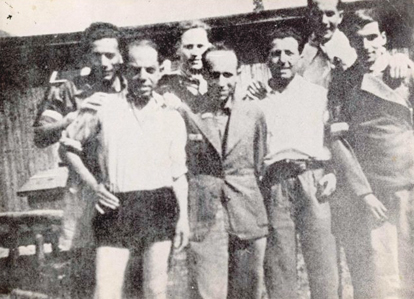
Seven of the forgers pose together shortly after their liberation from Ebensee on May 5, 1945. Front row, from left: Salomon Smolianoff, Ernst Gottlieb, unknown and Max Groen. Back row, from left: Adolf Burger, unknown and Andries Bosboom. Photo: Courtesy family of Max Groen  

The beautiful Toplitzsee, near the range of the Totes Gebirge (Death Mountains), which served as a dumping ground for the Nazis at the end of the war. Millions of counterfeit pounds, plus a printing press, have been found in its waters. Persistent rumors of sunken Nazi gold — or secret SS records — continue to draw treasure hunters to the lake. PHOTO: GEORG BIEMANN 
|
|
||||||||||||||||||||||||||||||
